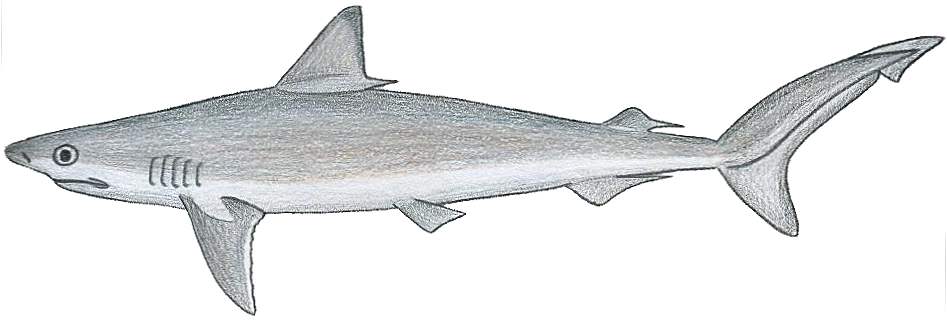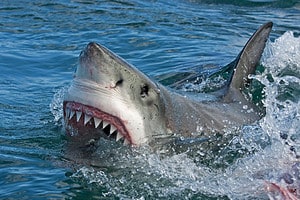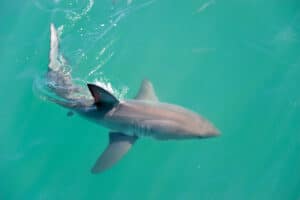We’ve already told you about the smallest sharks in the world, and we were thrilled to see the awe-inspiring dimensions of those little predators. But now, we focus on domestic shores. Today, we’re going to tell you about the seven smallest sharks found in U.S. waters. These little critters will amaze you with their miniature stature, and you’ll learn how truly fascinating they are. We’ll tell you where they live, if they’re dangerous, and other facts you should know before jumping in and meeting them face to face.
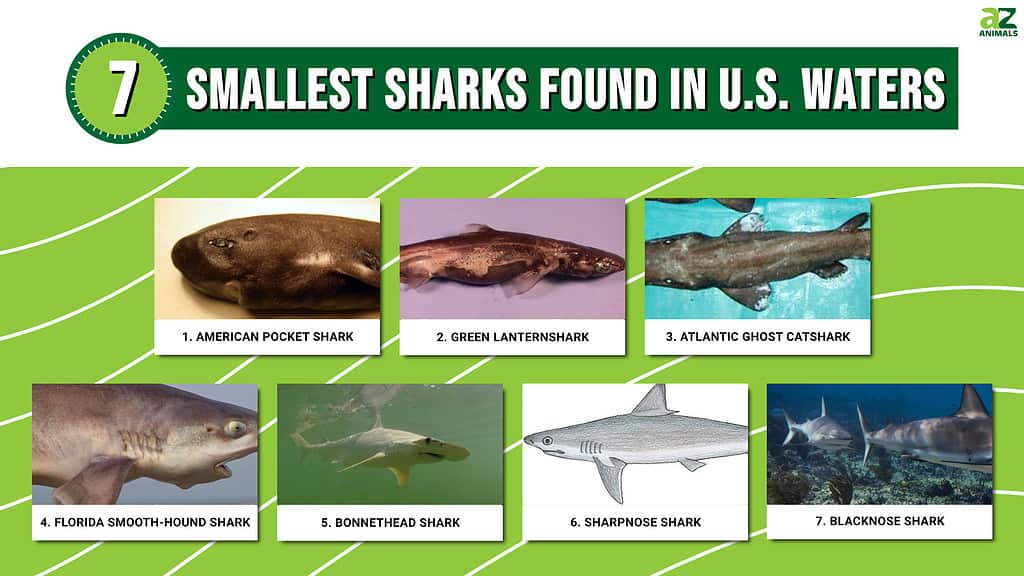
What’s Included in our List?
When most of us think of sharks, great whites and hammerheads come to mind, but not all sharks are huge and threatening. In this list, we’ll look at sharks that are smaller in size, typically less than 4 feet in length. Many of these species are so tiny that they’re often accidentally captured during fishing expeditions, so some are endangered. Here’s our list of smallest sharks in the United States!
1. American Pocket Shark
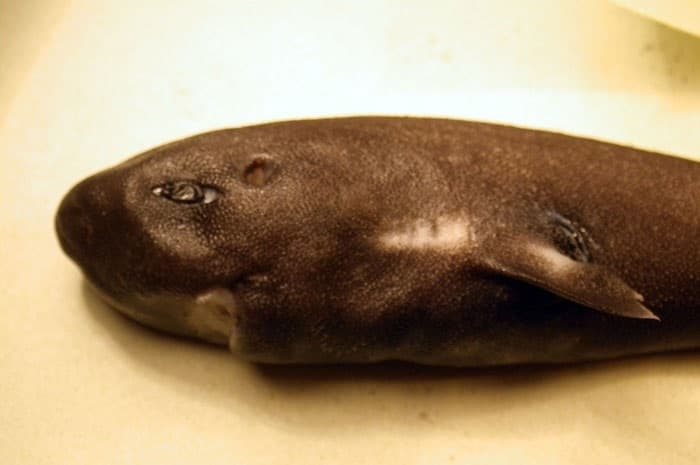
The American pocket shark was discovered a few years ago and made public in 2019.
©M. Grace/NOAA/NMFS/SEFSC/Mississippi Laboratories, Public domain, via Wikimedia Commons – Original / License
One of the smallest sharks found in U.S. waters was recently discovered in 2010 when a group was studying sperm whales in the Gulf of Mexico. The species was made public only a few years ago in 2019. In addition to being only about 5.5 inches long, this shark is also unique due to its ability to squirt luminous liquid. Researchers believe the substance, which comes out of gills near the shark’s head, is used as a defense mechanism. Currently, there is not enough information or numbers to say if this species is endangered.
Dangerous or Not: Not. The American pockets are barely big enough to bite your toe, and it’s not interested in human consumption. There are no records of it attacking humans, but it is still a young species.
2. Green Lanternshark
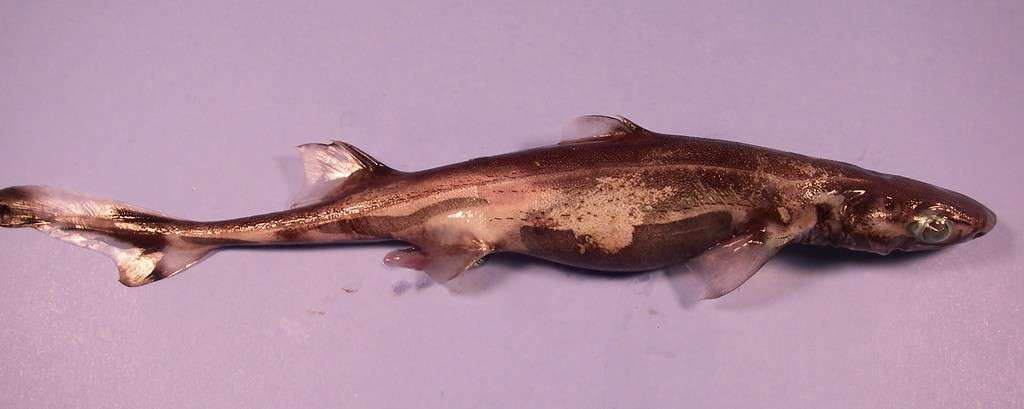
Green lanternsharks typically only reach about 10 inches in length.
©SEFSC Pascagoula Laboratory; Collection of Brandi Noble, NOAA/NMFS/SEFSC, Public domain – Original / License
Hang around the Gulf of Mexico for a while, and you may eventually run into the green lanternshark. These sharks are very tiny. They’re typically born at 3.5 inches. However, even in adulthood, they typically only reach about 10 inches in length. They’re often identified by their blunt faces, huge eyes that cover much of their faces, and protruding spines. Although small, they have up to 34 rows of teeth in the upper jaw and 32 in the lower jaw. They also have two dorsal fins, with the second fin being larger than the first.
The green lanternshark has been found around the world, in places like Honduras, Cuba, Panama, and the Yucatan Peninsula. In America, they’ve been spotted off the coast of Florida and Texas. They’re a deep-sea species that can swim to depths of 3,000 feet, but they typically hang out at around 1,150 feet. They are unique because they hunt in packs, so they can combine efforts to bring down prey.
Dangerous or Not: Not. They’re not known to attack humans outright. There are no recorded attacks on humans by the green lanternshark. And if you were nibbled, you may not even realize it.
3. Atlantic Ghost Catshark

Most ghost catsharks are dark gray or black and have white fin tips.
The ghost catshark is typically found in the Atlantic Ocean. The male ghost catfish grows to about 2.5 feet long, and the female grows to about 2.8 feet. You can identify them due to their broad head and elongated snout. Watch them from the side, and you can see their pointed teeth. Most ghost cat sharks are dark gray or black and have white fin tips.
Ghost catsharks live in South Africa and West Ireland, as well as Massachusetts and other Eastcoast areas of the United States. They swim pretty deep and are typically found at depths of 2,000 to 6,000 feet.
Dangerous or Not: Not. This species has a diet that consists of squid, shrimps, crustaceans, small fish, and other tiny creatures. They won’t attack humans, but even if they could, it would be non-fatal. They’re so harmless, in fact, that many people buy them and put them in their fish tanks.
4. Florida Smooth-Hound Shark
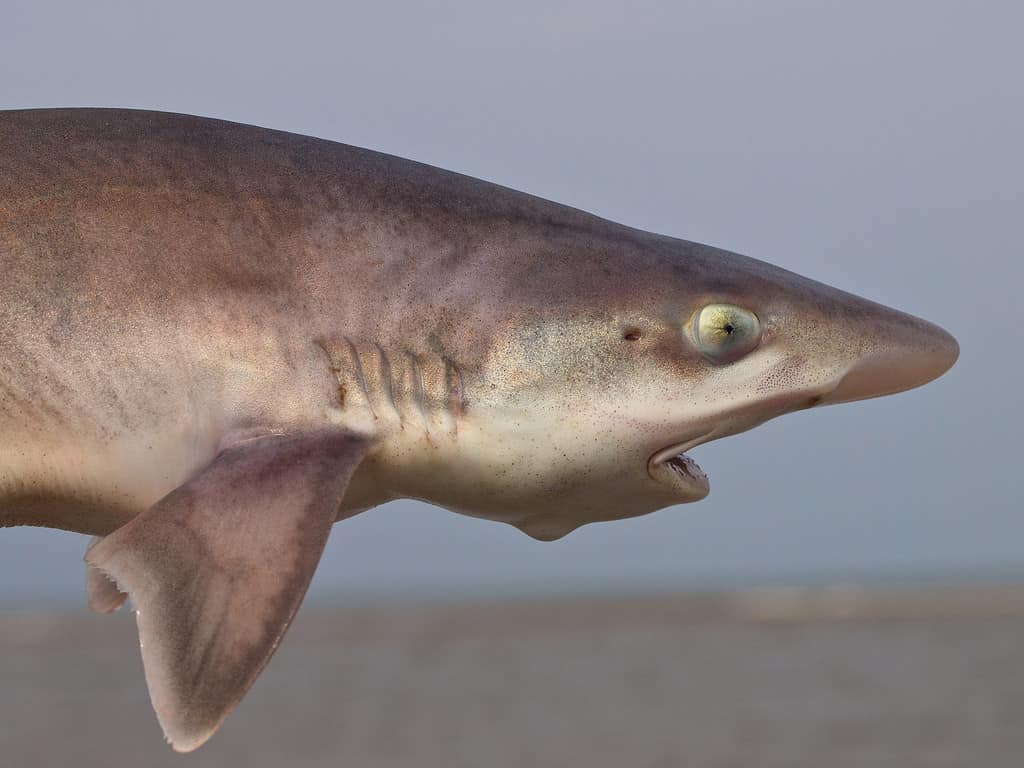
The common smooth-hound shark typically grows to only about 3.6 feet.
©CreativeNature_nl/Shutterstock.com
Though not as tiny as some of the others on this list, the Florida smooth-hound shark only grows to about 3.6 feet long. You’ll notice this shark due to its long pectoral fins, pointed snout, and asymmetrical tail. It is typically gray or grayish brown on top with a cream-colored underbelly. They have a long, slender body and two dorsal fins, both of which are rather long when compared to the rest of their bodies.
The smooth-hound has plenty of teeth, but most of them are short with stumpy cusps. This breed has been found far away in Brazil and Venezuela, but as the name suggests, it’s also found around the coasts of Florida in the Gulf of Mexico. They’re not always easy to spot since they often spend most of their time at the ocean floor. However, most Florida smooth-hound sharks have been spotted at a maximum depth of only 290 feet.
Dangerous or Not: Not. The shark’s teeth are not made for tearing into human flesh. Rather than predator, this species is typically the prey of hammerhead and blacktip sharks. The Florida smooth-hound shark is considered “Near Threatened.”
5. Bonnethead Shark
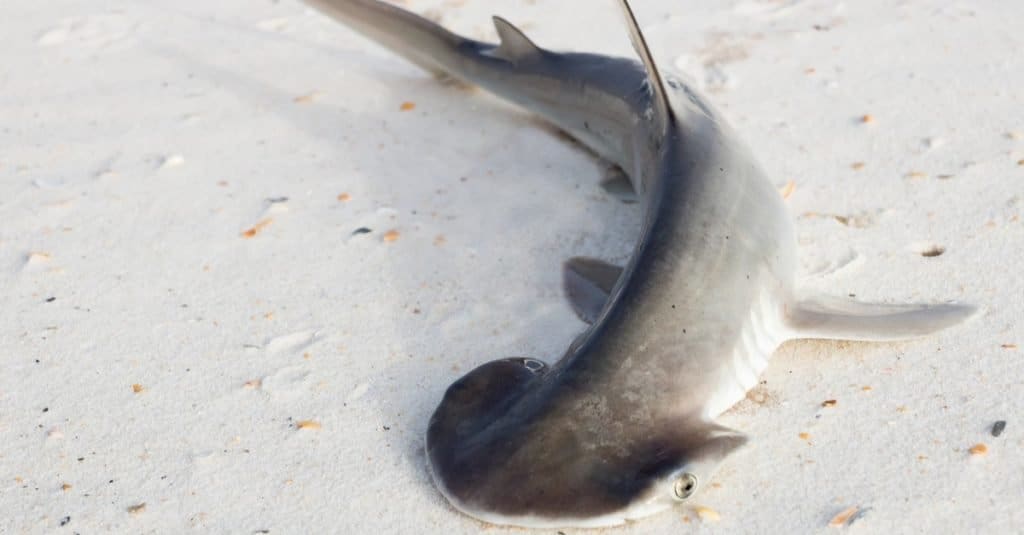
The bonnethead shark grows to 39 inches long at the most (females).
©IrinaK/Shutterstock.com
Typically found in the Gulf of Mexico, the bonnethead shark is a member of the hammerhead shark family. However, it is the smallest of the hammerheads. Males grow to about 20-30 inches in length, while the females can be as large as 39 inches long.
This type of shark is likely to be seen in large aquariums at tourist attractions. The shark is often gray or grayish brown, with a broad and wide head that more resembles a shovel than a hammer. It’s also identifiable by its long tail and numerous fins.
If you see a bonnethead shark, then try to let it be. The shark is a frequent prey of larger sharks. The species is also experiencing major global reduction due to overfishing, and it is currently a “Threatened” species.
Dangerous or Not: Not. It doesn’t have sharp teeth. Instead, the shark mostly relies on its back molars that are used to grind down shells and crustaceans. Though it eats sea animals, it also eats plants, making it the only omnivorous shark.
6. Sharpnose Shark
The sharpnose shark is one of the longest on our list, as it typically reaches 2-4 feet in length. Floridians often find this shark cruising around in bays and estuaries, but they can also be spotted just offshore. You can often identify the sharpnose shark by its famous sharp nose, which is a bit flat. The shark also has a slender body and brown or olive-gray coloring that’s often paired with white spots on the back.
Though the sharks are often found around Florida, you’ll still often see them as far north as New Brunswick, Canada. You can also see them off the coast of Virginia and Texas. The sharpnose can go as deep as 900+ feet, but they’re typically at around 32 feet, which is why they are often fished.
Dangerous or Not: Not. The sharpnose shark’s diet mostly consists of shrimp and fish, and it occasionally eats the bait off of fishing hooks. It’s not interested in human consumption, and there are no documented stories of attacks on people.
7. Blacknose Shark
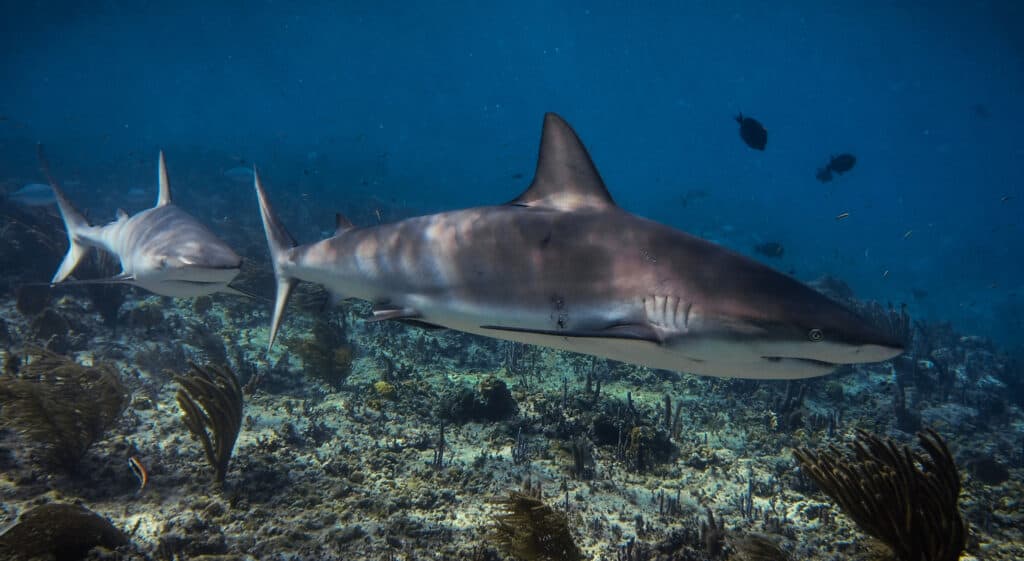
It may look large but blacknose sharks only grow to about 4.5 feet long at most.
©iStock.com/ Ryan Cake
Another shark you may see in the Gulf of Mexico near Florida is the blacknose shark. At its longest, the shark is about 3.5 to 4.5 feet, and they only weigh about 23 pounds. The shark can be identified by the dark spot on its long snout. They’re also typically a yellow-gray color, helping them to blend in with the ocean floor.
This shark has been spotted as far south as Brazil, but it’s typically found in the Gulf of Mexico in the southern USA near Florida. This shark doesn’t go too deep, often swimming about 30 feet below the surface. Sadly, they also have a short lifespan of about 10 years. Even worse, the blacknose shark is often fished, so their population is endangered, and they are considered “Near Threatened.”
Dangerous or Not: Not. Although the blacknose shark will often put on a threat display when cornered, they are not known to bite. There are no human attacks on record. Their diet primarily consists of pinfish, small bony fish, and the occasional octopus.
Conclusion
While it would likely be memorable to see one of these sharks in the wild, remember that many of them are endangered, so enjoy them from a distance. With new species still being discovered, only time will tell if we’ll find new small sharks in the future. In the meantime, enjoy your swim!
| Rank | Common Name | Scientific Name | Typical Longest Length |
|---|---|---|---|
| 1 | American Pocket Shark | M. mississippiensis | 5.5 Inches |
| 2 | Green Lanternshark | Etmopterus virens | 10 Inches |
| 3 | Atlantic Ghost Catshark | Apristurus manis | 2.8 Feet |
| 4 | Florida Smooth-Hound Shark | Mustelus norrisi | 3.6 Feet |
| 5 | Bonnethead Shark | Sphyrna tiburo | 39 Inches |
| 6 | Sharpnose Shark | Rhizoprionodon terraenovae | 4 Feet |
| 7 | Blacknose Shark | Carcharhinus acronotus | 4.5 Feet |
The photo featured at the top of this post is © IrinaK/Shutterstock.com
Thank you for reading! Have some feedback for us? Contact the AZ Animals editorial team.




